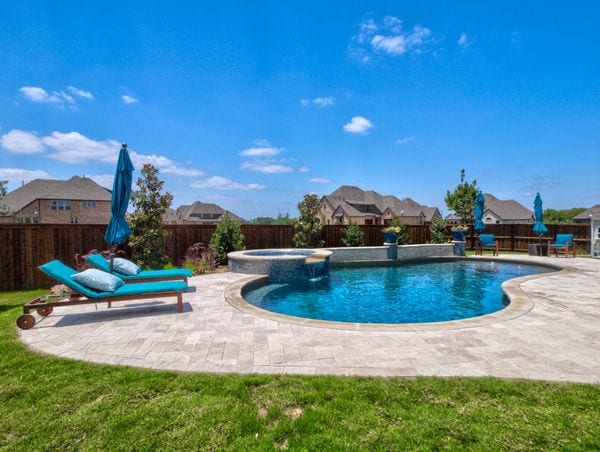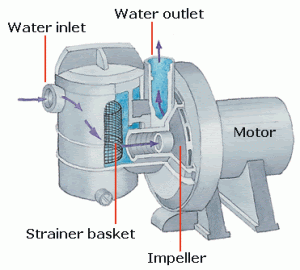
Your pool pump is the heartbeat of your pool. Keeping your pool’s water circulating regularly is one of the best ways to get rid of debris and stay ahead of algae growth. That means it’s essential for you to keep your pump running smoothly and to be able to tell when it isn’t. How do you know when your pump is struggling? First, here’s a brief overview of how a pool pump works.
A Pump In Action

The pool pump’s job is to circulate water through the pool filter and return it to the pool. As it runs, the pump sanctions water from the pool through the water inlet. After passing through the strainer basket, the water becomes pressurized and is pushed through the water outlet, on through the filter and back into the pool. The entire process is made possible by a shaft driven impeller which is powered by an electric pump motor.
Now that you know the basics of a pool pump, here are some common symptoms of a repair just waiting to happen.
Common Pool Pump Problems
Water Leaks
There are several spots where your pool pump could be leaking. First, check the pump lid to make sure it is threaded on correctly and has a good seal. Next, make sure that your pump inlet and outlet are free of drips. If your leak is coming from one of these spots, you’ll need to re-tighten or replace the connection.
The final spot where leaking can often occur is at the center of your pool pump where the pump housing connects to the pump motor. Inside, there is a two-piece seal that keeps water from entering the motor side of the pump. If this seal is broken you’ll see water dripping out the bottom of your pump. A new shaft seal is needed and the pump will need to be powered off and disassembled in order to make the repair.
Air Leaks
In order for the pump to pull water from the pool, the suction side of your pump system must be air-tight. One tell-tale sign of an air leak in your pump system is bubbles blowing into your pool through the return lines. Here’s what’s happening:
As your pump is trying to pull water from the pool by creating a suction, somewhere air is sneaking into the system. This leads to your water moving slowly or not at all through the pump and on to the filter.
There are several spots where air could be entering your system. Make sure your pump lid is properly sealed and check all the connections on the suction side of your pump, (the part of your system between the pool and the impeller). One way of finding air leaks is to spray shaving cream on a spot you suspect is leaking. If there’s a leak, the suction will pull the shaving cream through the gap and you’ll be able to see exactly what needs to be replaced.
Mechanical Issues
Like anything with moving parts, a pump will break down over time and have some mechanical issues. Here are two of the most common issues that are easy to fix.

Bad Capacitor – If your pump is making a humming noise but refuses to start, there’s a good chance that your capacitor needs to be replaced. The capacitor acts as a large battery for your pump, giving it a jolt of electricity when it needs to switch on. Like batteries though, a capacitor can lose power over time. To replace a capacitor, turn off the power to your pump, remove the capacitor cover, and locate the capacitor.
IMPORTANT: While wearing eye protection, make sure to short-out the old capacitor before removing it to avoid being shocked. (The capacitor can store an electric charge even though the power is off.)
Clogged Impeller – The pump impeller can become clogged when debris from the pool water squeezes past the strainer basket. (Always be sure that your strainer basket is damage-free and in place before running your pump.) When this happens, the water flow is reduced or, in some cases, completely stopped. To undo the clog, turn off the power to your pump, disconnect the pump motor from the pump housing and remove the debris by hand or with a screwdriver.
Planning Ahead

As you diagnose problems with your pool pump, keep in mind that putting too much money into an old piece of equipment can be counter-productive. An older, single-speed pool pump runs at the same speed whenever it’s turned on. In contrast, a newer variable speed pump allows you to adjust your pump’s settings to meet your pool’s needs.
This new style of pool pump provides better efficiency and energy savings for you as a homeowner or property owner. In fact, when compared to an older single-speed pump, a variable speed pump could save you over $1,000 in energy costs during the first year after purchasing. Variable speed pumps are also being mandated by the US Department of Energy. Starting July 18, 2021, most single speed pool pumps will no longer be manufactured in or imported to the USA. So, if you find yourself with a pump on it’s last leg, consider upgrading to a variable speed pump for your pool.
Howdy Dallas
Don’t let a hiccup in your pool pump spoil your weekend fun. If you need help pool filter problems or if you prefer to have a licensed technician on the job, contact Liquidus Pool Services for help.
Enjoy your weekend!
